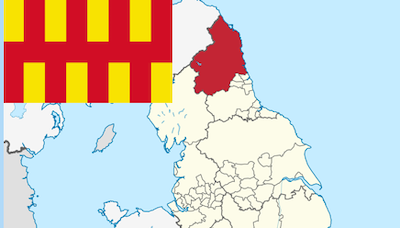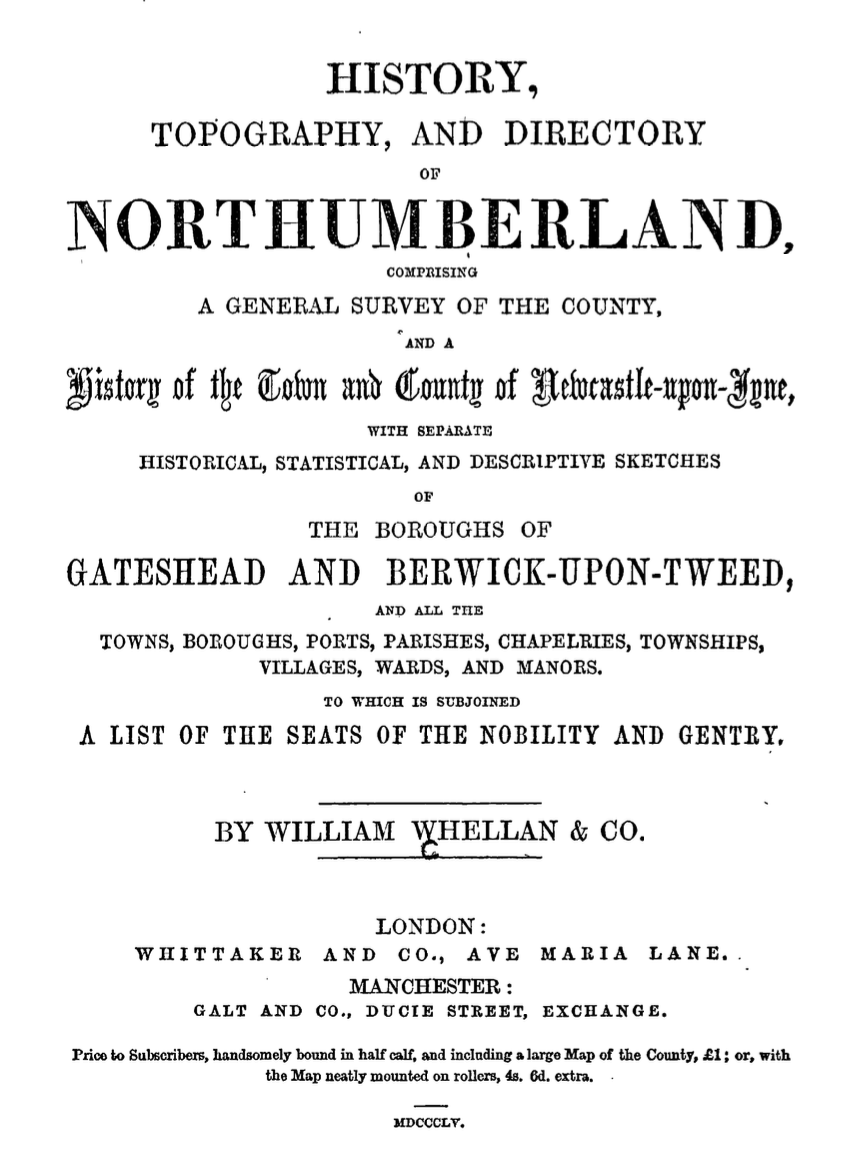Topics > Northumberland > Civil Parishes in Northumberland > Ford Civil Parish > Ford Parish (Northumberland), 1855
Ford Parish (Northumberland), 1855
Extract from: History, Topography, and Directory of Northumberland...Whellan, William, & Co, 1855.
FORD PARISH
FORD parish is bounded on the north by Norhamshire, on the west by Branxton, on the south by Doddington and Kirknewton, and on the east by Lowick. It comprises an area of 11,466 acres, and its population in 1801. was 1,903 ; in 1811, 1,860; in 1821. 1,807; in 1831, 2,110; in 1841, 2.257; and in 1851, 2,322 souls. The lands here are fertile, and contain valuable seams of coal, and beds of slate, limestone, whinstone, and freestone. This parish is divided into three freehold estates, viz.: Etal, Ford, and Pallinsburn, which are subdivided into five constablewicks, namely, those of Crookham, Etal, Ford, Hetherslaw, and Kimmerston. Etal constablewick includes the whole of the Etal estate. Ford constablewick comprises Ford Mill, and all that portion of the Ford estate lying on the east side of the river Till. Kimmerston constablewick comprehends Kimmerston and Broomridge. Hetherslaw constablewick includes the remainder of the Ford estate, west of the Till, except Crookham and Barelaw, which, with the Pallinsburn estate, constitute Crookham constablewick.
CROOKHAM is a constablewick and village comprising the whole of the Pallinsburn estate, and Crookham, and Barelees, which belong to the Ford estate, The trustees of the late R. C. Askew, Esq., are the owners of Pallinsburn. THE VILLAGE of Crookham is situated two miles W.N.W. of Ford, and nine miles N.N.W. of Wooler. The Presbyterian Chapel is a good commodious building capable of accommodating about 1,600 persons, Rev. William Edmonds, minister. There is a day school attached to this chapel, John Hardy, teacher. The NATIONAL SCHOOL is a good stone building, and will accommodate 120 pupils. Average attendance, 85 children. It is used as a chapel of ease to Ford Church, the minister of which officiates here. PALLINSBURN HALL, an elegant modern brick structure, is pleasantly situated in the midst of beautiful pleasure grounds. In its vicinity there is a fine lake, which, from March to Autumn, is frequented by numerous flocks of black-headed gulls, The mansion is at present occupied only by servants, the heir to the estate being a minor. Barelees, Bird Nest, Bruce's Castle, Keek Out, Mardon, and Pallinsburn, are hamlets in this constablewick.
|
Allan William, blacksmith Douglas William, baker, grocer, & butcher Edmonds Rev. William, (Presbyterian) Frizell Robert, schoolmaster Graham Stephen, shoemaker Grieve Peter, farmer, Barelees Harbottle John, joiner and cartwright Hardy John, schoolmaster Mason Thomas, land agent and fanner, Pallinsburn Logan Ann, vict. Blue Bell, Pallinsburn |
Marshall James. blacksmith, Pallinsburn Railston Jas. gfllllekeeper, Mardon Cottage Robertson William, vict. Red Lion Smith Thomas, farmer, Mardon Steel Alexander, tailor Steel John, joiner Trotter Alexander, gardener Tulip Elizabeth, farmer, EastField, Pallinsburn Wilson George, shoemaker Whitehead Ann, grocer Winter Robert, vict. Wheat Sheaf |
CARRIER. -To Berwick, William Robson, on Saturdays.
ETAL is a constablewick and village, the property of the Earl of Glasgow. The manor of Etal was formerly possessed by the .Manners family, who held it under the barony of Wooler, for the annual service of half a knight's fee. One of this family, Sir Robert de Manners was governor of Norham Castle, in the reign of Edward III., and on the night of Edward's coronation he completely routed a party of Scots who attempted to obtain possession of the fortress under his charge. For this, and several other important services, he was rewarded by the King with a grant of land in the Berwick bounds, and afterwards represented Northumberland in Parliament. On his demise, his estates and honours devolved upon his son John, one of whose successors Robert de Manners, for his services on the borders, received a portion of the forfeited estates of Sir Robert Ogle. This Robert was a firm adherent of the house of York, opposing the Lancastrians on every opportunity. He married Eleanor, the eldest daughter and co-heiress of Thomas. Lord Roos, and had by her a son George, who espoused Anne, daughter of the Duchess of Exeter, and had by her Thomas, Lord Roos, who having livery of all the manors, estates, and castles, which came into his family by Eleanor, bis grandmother, and Isabel his aunt, was advanced to the title and dignity of Earl of Rutland, in 1525. In 1546 we find the Etal estate was possessed by Thomas Carr, Esq.; it was crown property in 1667, but it shortly afterwards passed to Sir Robert Carr, Knt., on whose death it was again sequestered, and not restored till a composition of £539 8s. 7d. was paid for it in 1653. Sir William Carr, son of the Sir Robert just mentioned, erected Etal House, and left an only daughter, who was espoused, in 1762, by James, Earl of Errol, whose second son succeeded to this estate on the death of his maternal grandfather, in 1797, but on the demise of his elder brother, in 1798, he became Earl of Errol and, in accordance with his grandfather's will, relinquished the Etal estate in favour of his sister, who died in 1801. Her son and heir survived her only six years, when the estate passed to his maternal aunt, who had married the Earl of Glasgow, in whose family Etal still continues.
THE VILLAGE: of Etal is situated on· the west bank of the river Till, nine miles N.N.W. of Wooler. Here is a Presbyterian Chapel, erected previous to 1740, and rebuilt in 1800. It is a commodious stone edifice, capable of accommodating about 650 persons. Rev. Thomas Robinson, minister. ETAL SCHOOL is under the patronage of Lord and Lady Fitzclarence, James Mack, teacher. The venerable ruins of the once imposing Castle of Etal, are situated at the west end of the village. This fortress is supposed to have been erected in 1341, by Sir Robert de Manners, and was, for a long period, the residence of the deputy warden of the marches. Two of its old towers and a portion of the court wall are all that remain to attest its former greatness. ETAL HOUSE, the residence of Lord F. Fitzclarence, is a plain stone mansion, surrounded by extensive plantations.
Berry Hill, New Etal, Hay Farm, Letham Hill, Errol Hut, Rhodes, Slainsfield, and Watchlaw, are hamlets in this constablewick.
POST OFFICE, ETAL. - James Mack, postmaster. Letters arrive at 5 p.m., and are despatched at 9 a.m.
|
Aitchison William, blacksmith, Errol Hut Anderson Geo. and Co. coal owners, Etal Colliery Black Thomas & Son, farmers, Hay Farm Fitzclarence Lord F. Etal House Dippie Adam, grocer Elliott Adam, shoemaker Hutchinson Thomas, shoemaker Jones John, gamekeeper · Laidler Thomas, farmer, Letham Hill Lisle George, butcher |
Mack James, schoolmaster McLeod Mary, vict. Black Bull Ogden John Biss, farmer Berry Hill Paxton Matthew, gardener Robinson Rex. Thomas, (Presbyterian), The Manse Short Henry, farmer, Rhodes Short Henry, corn miller, Etal Mills Steel Thomas, farmer, New Etal Tully John, joiner Wilson Robert, farmer, Watch Law |
FORD is a constablewick and village in the parish of the same name, the property of the Marquis of Waterford, who is also lord of the manor, and holds his courts leet and baron annually. The manor of Ford anciently belonged to a family that bore the local name. It was transferred by marriage, to the Herons of Hadstone, one of whom was captain of the castles of Barnbrough, Pickering, and Scarbrough, and warden of the forests north of the Trent, as also High Sheriff of Northumberland for eleven successive years. His son, Sir William Heron, was summoned to parliament, in the reign of Edward III., in 1371, and was ambassador to France, in the reign of Henry IV. He died, in 1404, and was succeeded by his nephew, who was high sheriff of the county from 1441 to 1445 ; but he suffered attaineder, in 1461, for his attachment to the House of Lancaster, though his estates were afterwards restored by Edward IV. On the demise of William Heron, in 1536, the estate passed by marriage to Thomas Carr, Esq., of Etal, after whose death it was claimed by George Heron of Chipchase, in virtue of an entail made by Sir William Heron, in the reign of Henry VIII. The daughter and heiress of the above mentioned Thomas Carr, Esq., married Sir Francis Blake, whose daughter Mary married Edward Delaval, Esq., after whose decease, in 1808, Ford was possessed by his relict; and, on her death, in 1822. it passed to her granddaughter, the Marchioness of Waterford, on whose demise, in 1827, it became the property of the Marquis of Waterford, the present proprietor.
THE VILLAGE of Ford is situated on an eminence on the east bank of the Till, where there is a good stone bridge seven miles N N.W. of Wooler. The situation of this village is very picturesque; and its old castle, with the beautiful scenery by which it is surrounded, are much admired. THE CHURCH dedicated to St. Michael, was enlarged and beautified in 1852, at an expense of £1,500, and is now a very neat edifice. The Marquis of Waterford, the Earl of Glasgow, the trustees of the late R. C. Askew, Esq., the church-building societies, and the parishioners were liberal subscribers towards its renovation. The parish register commences in 1683; and the living, a rectory in the archdeaconry of Lindisfarne and deanery of Norham, is valued in the Liber Regis at £24 ; gross income, £628. Patron, the Marquis of Waterford, and the Rev. Thomas Knight, B.A., is rector. FORD SCHOOL is attended by seventy pupils, of whom thirteen boys, and thirteen girls, are educated at the expense of the Marquis of Waterford. David G. Smith, teacher.
FORD CASTLE, a seat of the Marquis of Waterford, is situated to the west of the village. It was erected in 1287, by Sir William Heron, and was re-edified by the late Lord Delaval. Two old towers are the only portions of the ancient structure remaining in the present edifice, which was erected in 1761-4. The centre of the south front is formed by a semi-hexagonal projection, surmounted by square turrets. On the west side of the area, in front, is an old square tower, composed of two turrets, rising one above the other; the upper one being so much less than that which supports it as to afford a spacious battlement. The area is encircled by a wall, which is protected by turrets placed at convenient distances, and at each corner there is a strong tower. The Castle of Ford is often mentioned in connection with the wars between England and Scotland. The Scots under the Earls of Fife, Match, and Douglas, made an incursion into Northumberland, in 1385, and during their progress demolished this castle as well as those of Wark and Cornhill. It was. aloo captured by the Scots previous to the Battle of Flodden Field, and in 1549 the same enemy, under the command of D'Esse, a French general of great military skill, made an attack upon this castle, and laid the greater part of it in ashes.
Ford Constablewick includes the village of Ford, and the hamlets of Ford Bridge, Ford Common, Ford Forge, Ford Hill, Ford Hill, Ford Moss, and Ford West Field. At Ford Moss there is a colliery, worked by the Marquis of Waterford, which gives employment to about seventy individuals. Robert Allan, manager. Ford Moss School is under the patronage of the Marquis of Waterford, and has an average attendance of fifty children, John Kidd, teacher.
|
Allan A.E. & Co. grocers, drapers, and iron-mongers, Ford Forge Allan Mark & sons, joiners and cartwrights, Ford Forge Allan Robert, colliery agent, Ford Moss Aynsley Henry, stonemason Black James, cornmiller (T. & 1. Black); ho. West Heaton Black John, farmer, Ford West Field Black John, spade and shovel manufacturer (Thomas Black and Sons); ho. Ford West Field Black Thomas and James, cornmillers, Ford Mills Black Thomas & Sons, spade, shovel, and agricultural implement manufacturers, Ford Forge Blackdew Rev. Fred. Chalfont, M.A. Ford Castle Blackdew John C., Esq. land agent, Ford Castle Carpenter Mr. Geo. Charles, Ford Cottage Chisholm Raph, junior, farmer, Ford Hill Cristal Thomas, farmer Cristal Thomas, vict. Delaval's Arms Drysdale William, grocer, Ford Common Dunn Richard, gamekeeper Fish John, shoemaker |
Grey George, slater· Hall Mark, stonemason Hunter Robert, shoemaker Hunter Robert, farmer, Ford wood Hutchinson Alexander, blacksmith Jackson Thomas, tailor Kidd John, schoolmaster, Ford Moss Knight Rev. Thomas, B.A., rector Neal Jonathan and Thomas, stone!llasons Nesbit John, tailor Ormston John, forester Ruel Mr. John Rutherford Thomas, farmer, Roughtin Lynn Short Edward, joiner Smith David G. schoolmaster and parish clerk Smith John, gamekeeper Smith Samuel, tailor Struth Peter, grocer & draper, Ford Bridge Thomas William, bailiff to the Marquis of Waterford Towns Mr. Nicholas |
HETHERSLAW constablewick comprises the hamlets of Blinkbonny, Brick Sheds, Encampment, East, Mid, and West Flodden, Henlaw, Hetherslaw, Linthaughs, Look-out, Mouut Pleasant, Sandyford, and Oakhall. THE HAMLET of Hetherslaw is situated one mile W.N.W. of Ford. Flodden Hill, in this neighbourhood, was the scene of the celebrated battle of Flodden Field, which was fought on the 9th September, 1513, between the English commanded by the Earl of Surrey, Lord Dacres, and other noblemen; and the Scotch under King James IV. This decisive conflict is sometimes called the battle of Branxton, as it was partly fought, and finally decided, by the death of King Jaroes, and the total defeat of his army near that place. Jaroes, the Scottish King, had long complained of Henry's retention of the jewels which his father had bequeathed to Margaret, the Scottish Queen, and was enraged at the recent death of Barton, his gallant admiral, the pride of Scotland, whom the English, accusing of piracy, bad attacked and slain. Eager to vindicate the honour of his crown, James listened gladly to the proposal of France, and while Henry was still engaged upon the continent, crossed the borders with his army. The defence of England devolved upon the brave Earl of Surrey. When this leader beheld the strong position of the Scottish camp, with its only accessible quarter bristling with cannon, be marched on as if for Scotland, and returned to attack the enemy on the opposite and unguarded side of the hill. James immediately occupied another of the Cheviots, and, having arranged his army into several distinct bodies, marched down to meet the charge of the Earl. After a brief struggle, a large body of the Scottish spearmen drove back the right wing of the English, while encircled with a gallant array, James pushed on, despite of all the efforts of his adversaries, to within a few yards of the royal standard. Notwithstanding the panoply in which he, and his followers were cased, the clouds of English arrows sped not in vain ; yet still he pressed forward, with ranks ever closing as fast as his warriors fell. The billmen of England tried their deadly weapons, but no matter, the king toiled on, and with spear and battle-axe, with sword and mace, he hewed out on rushed down a bloody and difficult path. Vain, however, were his gallant efforts, the war-cry of the English thundered upon his rear, his spearmen had been swept away from the field. and the victors, exulting and resistless, were closing around him. Soon his ranks were broken, all was confusion and despair, and, amid the dead bodies of thirty of his faithful nobles, with his hands hacked in pieces, his head gashed with a bill, and his body pierced with arrows, the Scottish King yielded up his life, Six thousand horses, and a park of seventeen pieces of artillery fell into the hands of the conquerors. The loss of the Scotch was variously estimated at from eight to twelve thousand men, among whom were a great number of knights and gentlemen, seventeen lords, twelve earls, four abbots and the archbishop of St. Andrews. Long did the Scotch tremble at the name of Flodden Field. Near to Branxton is a large upright pillar, erected as a memorial of this victory. On the summit of Flodden Hill is a natural rock, called the King's Chair, from which James had a good view of the English army and his own. The top of Flodden Hill is now covered with a large plantation of fir trees.
|
Phillips George, brick and tile manufacturer, Flodden Taylor John R. surgeon, Linthaughs
Farmers Brown Andrew, Linthaughs Duns William, Linthaughs |
Elliott William, Mount Pleasant Glendinning Henry, Blinkbonny Glendinning John, West Flodden Marshall Richard, Hetherslaw Steel Isaac, Middle Flodden Thompson Thomas, Encampment |
KIMMERSTON is a constablewick and hamlet in the above named parish. THE HAMLET of Kimmerston is situated one and a half miles south by east of Ford. BROOMRIDGE, a, hamlet in this constablewick, was formerly a considerable village; and from a passage in Florence of Worcester; Camden supposes it to have been the Brunanburgh, where King Athelstan defeated Anlaf the Dane, Constantine of Scotland, and Eugenitis the petty King of Cumberland, in 982. It was formerly a portion of the manor of Roddam.
DIRECTORY - John Piercy, blacksmith; and James Grey, farmer.










